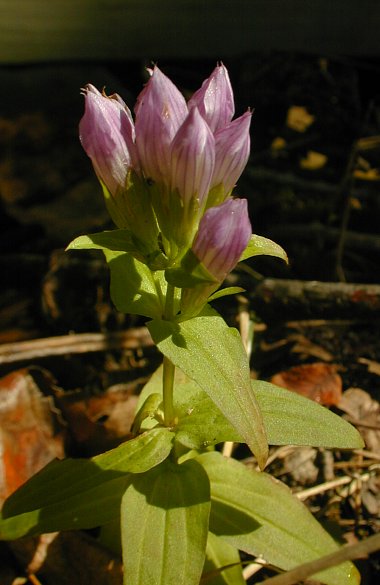Description: This wildflower is an annual or biennial about ½–2' tall. Small plants are unbranched or sparingly branched, while large plants form frequent lateral stems in the upper leaf axils. The stems are light green to reddish purple, 4-angular, and slightly winged; the central stem is erect, while the lateral stems curve upward. Pairs of opposite leaves occur along each stem, each pair rotating about 90° from the pair of leaves immediately below. The leaves are up to 2½" long and about half as much across, becoming slightly smaller as they ascend the stems. The leaves are ovate-cordate to ovate, sessile or slightly clasping at their bases, and smooth along their margins. Their upper surfaces are yellowish green, green, or tinted slightly purple; each leaf has 3-5 parallel veins. Both the stems and leaves are hairless.

The central stem
and upper lateral stems (if present) terminate in clusters of 3-7
flowers on short pedicels. Frequently, there are additional clusters of
1-5 flowers from the axils of the upper leaves. All of these flowers
are held stiffly erect. Each flower is about ¾" long and ¼" across; it
has a long tubular corolla and a short green calyx with 5 slender
teeth. The apex of each corolla has 5 triangular lobes that fold
together to form a point; the corolla is closed or nearly so. There are
no interconnecting fringes to join these lobes. The corollas are
blue-violet, purple, or nearly white; they have fine purple veins along
their sides. Inside each corolla, there are five stamens and a pistil.
The erect lobes of the calyx are narrowly oblong-lanceolate in shape.
Underneath the clustered flowers, the leaves are reduced to leafy
bracts. The blooming period occur from late summer to mid-fall and
lasts about 1-2 months. There is no noticeable floral scent. Each
flower is replaced by a seed capsule that divides into 2 parts to
release the numerous tiny seeds. These seeds are distributed by wind
and water. The root system consists of a taproot. This wildflower
reproduces by
reseeding itself; it does not spread
vegetatively.
Cultivation:
The preference is full sun to light shade, moist to dry conditions, and
a somewhat barren soil containing clay or rocky material. Competition
from taller plants should be restricted. The size of individual plants
and the abundance of their flowers can vary considerably depending on
the availability of moisture and nutrients.
Range & Habitat:
The native Stiff Gentian is occasional in the northern half of
Illinois, while in
the southern half of the state it is rare or absent. Populations of
this species may be declining. Habitats include hill prairies, upland
savannas, thinly wooded slopes, rocky meadows, banks of streams in
wooded areas, calcareous seeps, and edges of cliffs. This species is
usually found in high quality natural habitats, often where limestone
is close to the ground surface.
Faunal Associations:
So far, information about floral-faunal relationships for this species
has not been encountered. The long tubular shape of the closed corollas
suggests that long-tongued bees cross-pollinate the flowers.
Photographic Location:
The edge of a partially shaded cliff at the Pine Hills Nature Preserve
in west-central Indiana.
Comments:
Like several other gentian species, the flowers of Stiff Gentian
provide attractive blue-violet color during the fall; this is one of
the last species to remain in bloom. Stiff Gentian in Illinois consists
of var. occidentalis; the typical variety is found
east of Ohio. Stiff Gentian is easily distinguished by its peculiar
flowers, which are shorter (1" long or less) and more narrow (¼"
across) than the flowers of other gentians with closed corollas.
Sometimes, Stiff Gentian is still referred to as Gentiana
quinquefolia, but this genus has been reserved for the
perennial gentians, of which there are several species still extant in
Illinois.